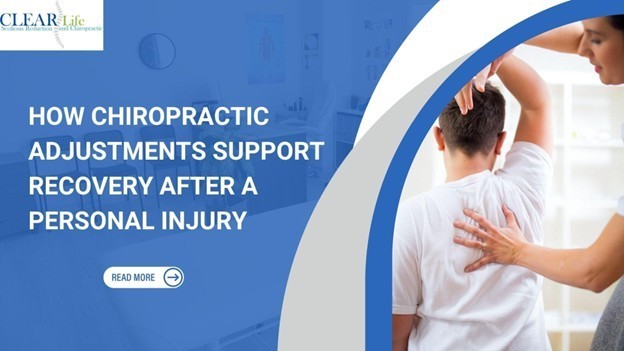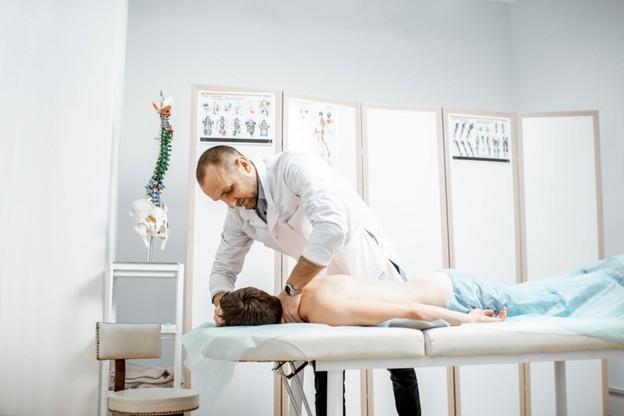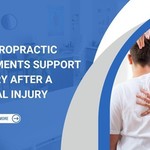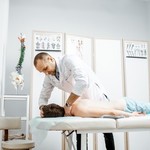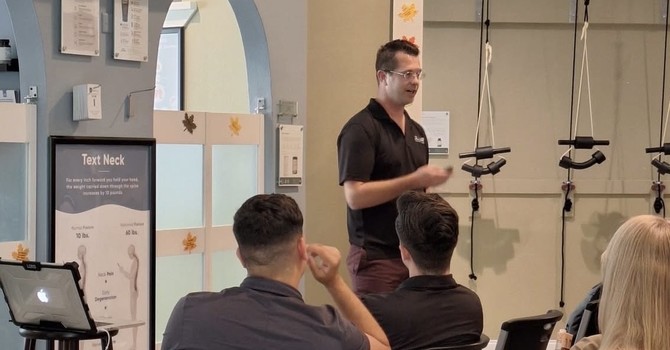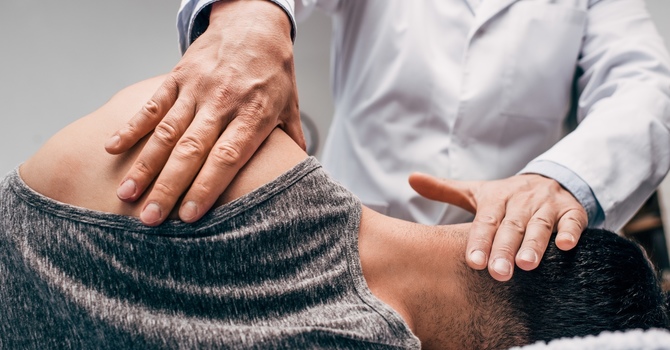How Chiropractic Care Support Recovery After a Personal Injury
Recovering from a personal injury can feel overwhelming, whether it happens suddenly from a slip, a fall, or a car crash, or builds slowly over time. The pain may not appear right away, but when discomfort lingers it makes daily life harder and keeps you from doing the things you enjoy. Getting the right care early can make a big difference, and chiropractic adjustments offer a natural way to feel better without surgery or heavy medication.
Here are some of the key ways chiropractic care supports recovery after a personal injury:
• Restoring joint movement, relieving nerve pressure, and supporting your body’s natural healing after accidents or strains
• Targeting the source of pain, such as joint misalignment or muscle imbalance, without relying on medication or surgery
• Encouraging faster recovery, reducing the risk of long-term issues, and helping you move with greater ease when care starts early
Chiropractic care is more than temporary relief. It focuses on restoring function, supporting long-term wellness, and helping you return to the activities that matter most. Let’s explore how these adjustments guide your body’s recovery and why they can be a smart step in your healing journey.
What Is a Chiropractic Adjustment?
Understanding how chiropractic helps after injury starts with knowing what an adjustment actually does. The chiropractor uses their hands or a tool to apply a controlled force to a joint, most often in the spine. The goal is to help the joint move the way it should. When movement returns, tension lowers, and the area starts to feel better.
After an injury, joints may not move correctly. Even a small misalignment can lead to swelling, muscle strain, or nerve irritation. Chiropractic adjustments fix this by targeting the exact joint that's out of place. The movement is quick and precise. Patients often feel lighter or more relaxed after the adjustment, as if something that was stuck finally released.
Many think of the spine as just a bone structure, but it's also part of the nervous system. Nerves run from the spine to every part of your body. If a spinal joint shifts and presses on a nerve, it affects more than just pain. You may feel numbness, tingling, or weakness in other areas. For someone recovering from a personal injury, an adjustment reduces stress on muscles and nerves, improves posture and balance, and allows the body to focus on repairing itself.
Real-Life Signs You May Need Chiropractic Help After Injury
Some symptoms don’t seem connected to your spine at first. But they might still be a sign that your body needs help recovering. After a personal injury, look for:
• Ongoing neck or back pain
• Headaches that return often
• Trouble turning your head or bending
• Pain while sitting or standing for long periods
• Numbness or tingling in your arms or legs
• Uneven posture or walking
These signs suggest that your joints or nerves might not be working as they should. A chiropractor can identify the cause and help your body regain balance.
Chiropractic Care vs. Medication or Surgery
Many people want relief without strong pain pills or risky procedures. Chiropractic care offers a drug-free option that supports long-term healing. Pain medication may block discomfort for a short time, but it doesn't fix what's wrong. Surgery can be helpful in severe cases, but it comes with a longer recovery time and cost.
Chiropractic adjustments focus on helping your body do what it was made to do—heal naturally. This is how chiropractic supports recovery: by addressing the source rather than covering symptoms. That's one reason many patients prefer this kind of care. It helps reduce pain at the source without masking it, letting your body actually repair itself.
How Chiropractic Care Targets the Root Cause of Pain
Pain can come from many sources. A bruise is easy to spot. But deep pain after injury often hides in the joints, nerves, and connective tissue. Chiropractic care looks beneath the surface. Instead of covering up pain with medication, it focuses on finding where the problem starts. Understanding how chiropractic helps post-accident recovery means recognizing these three hidden sources:
• Joint Misalignment: When joints are misaligned, the body moves poorly. One side works harder than the other. This causes strain and pressure. After a fall or crash, joints shift without you even knowing it. They might be just a little off, but over time, this affects your posture and movement. Adjustments bring the joint back where it belongs.
• Nerve Pressure: Nerves carry messages between your brain and body. If an injury causes swelling or joint shift, it may press on a nerve. This pressure leads to pain, tingling, or even muscle weakness. Chiropractic care relieves this pressure. With better nerve flow, your body responds faster to healing.
• Muscle Imbalance: When one part of your body hurts, other parts try to help. That's how muscle imbalance starts. You might walk with a limp or hold your neck stiffly. Over time, these habits strain your muscles. Chiropractic adjustments help fix the root cause so your muscles stop overcompensating, letting your whole body work together again.
The Role of Chiropractic Care
Recovering from injury isn't just about healing tissue. It's about getting your body back to full function. Chiropractic care plays a bigger role than just adjusting the spine. It supports how your whole body moves, feels, and reacts to injury. Here's how these chiropractic benefits after injury add up to complete recovery.
• Supporting Better Posture and Joint Motion: Good posture helps your body recover, but pain after injury often changes how you stand or sit. You may lean to one side without knowing it. Chiropractic care realigns the spine and improves posture. When your body is in better alignment, it heals faster. Similarly, joints need to move to stay healthy. If you stop moving because of pain, your joints stiffen and recovery slows. Chiropractors restore motion to locked joints. Once the area moves again, blood flow improves, muscles stop tightening, and pain decreases.
• Reducing Inflammation and Improving Balance: Inflammation is your body's way of responding to injury, but too much causes more harm than help. Chiropractors don't just work on bones; their care also lowers inflammation through better movement. This makes healing faster and less painful. Injuries also throw off your balance. You may trip more, walk unevenly, or avoid movement altogether. Chiropractic care improves how your joints work together. When the spine is aligned, your body balances better, helping you walk, stand, and move with confidence again.
• Supporting Spinal Ligament Recovery: Ligaments keep your spine stable. If they're injured, the spine becomes loose. This is common in whiplash cases. Chiropractors check for ligament damage with special tests. They adjust the spine gently to support healing without straining the tissue, ensuring your spine regains its natural stability.
• Avoiding Long-Term Damage: If injuries aren't treated, small problems can grow. Misaligned joints lead to uneven wear. Nerve irritation causes weakness. Over time, pain becomes chronic. Chiropractic care works early in the recovery process, helping stop long-term issues from developing before they take root in your body.
What Does a Chiropractic Adjustment Treat/Manage?
Pain from injury doesn't always follow the same pattern. It may show up right away or develop over time. Chiropractic care helps with many types of injury-related pain and movement problems. Understanding what conditions respond well to adjustments can help you decide if this approach fits your recovery needs.
• Whiplash and Neck Injuries: Car accidents often cause whiplash. The neck moves back and forth too quickly, straining muscles and shifting spinal joints. A chiropractor restores motion and calms nerve tension. This helps reduce headaches, stiffness, and dizziness that often linger weeks after the accident.
• Back Pain: Lifting something wrong or slipping on wet ground can strain your back. If the joints shift, muscles tighten to protect the area, adding to the pain. Adjustments help restore the joint's natural position. This gives the muscles a chance to relax and stop guarding, breaking the cycle of tension and discomfort.
• Shoulder, Hip, and Knee Strain: Joint pain in the arms or legs may be caused by poor spinal alignment. If the pelvis tilts or the spine shifts, the rest of the body works harder to adjust. Chiropractic care brings balance back to the core. As a result, pain in other joints starts to fade, even in areas that seemed unrelated to the original injury.
Benefits of Reducing Pain Through Chiropractic Care for Faster Recovery
Pain slows healing. It stops you from moving. It makes sleeping harder. And it adds stress to your daily life. By lowering pain, chiropractic care helps you recover faster and return to the things you enjoy.
Here are the key benefits of pain reduction through chiropractic care:
• Restores Natural Movement: When pain is gone, you can move more freely
• Supports Deep Tissue Healing: Less pain means less muscle tension and better blood flow
• Improves Sleep Quality: Adjustments reduce discomfort at night, helping you sleep longer
• Lowers Stress on Other Joints: Proper alignment stops the body from overcompensating
• Avoids Unnecessary Medication: With less pain, you don’t need to rely on pain pills
• Encourages Long-Term Recovery: Pain-free movement supports a return to normal life activities Pain shouldn’t be something you live with every day. Chiropractic care offers a way out. With each adjustment, the body moves closer to balance, function, and strength.
When to Seek Chiropractic Help
Injuries can fool you. The pain may seem small at first. You might think it will fade on its own. But days or weeks later, the soreness stays—or gets worse. That's why timing matters.
After a car crash, a fall, or a sudden hit during sports, it's smart to get checked. Even if you feel okay, your body may be hiding strain or joint shifts. Waiting too long gives those problems time to grow. Chiropractors are trained to spot changes in your spine and joints. They can find issues early, before pain spreads or function drops. You don't need a referral to schedule a visit. Most chiropractors accept new patients directly.
If you notice stiffness, headaches, tingling, or joint pain after an injury, don't wait. Starting care early gives your body a better chance to heal properly. It also helps you avoid long-term discomfort or repeated injuries. Chiropractic care focuses on movement, alignment, and function. The sooner you start, the sooner you feel like yourself again.
Pain doesn't have to be permanent, and hidden damage doesn't have to become chronic. Clear Life Scoliosis Reduction and Chiropractic offers care that follows what your body needs. We listen, we look deeper, and we help you move forward with steady, focused support. Reach out when you're ready.

Admin
Contact Me
